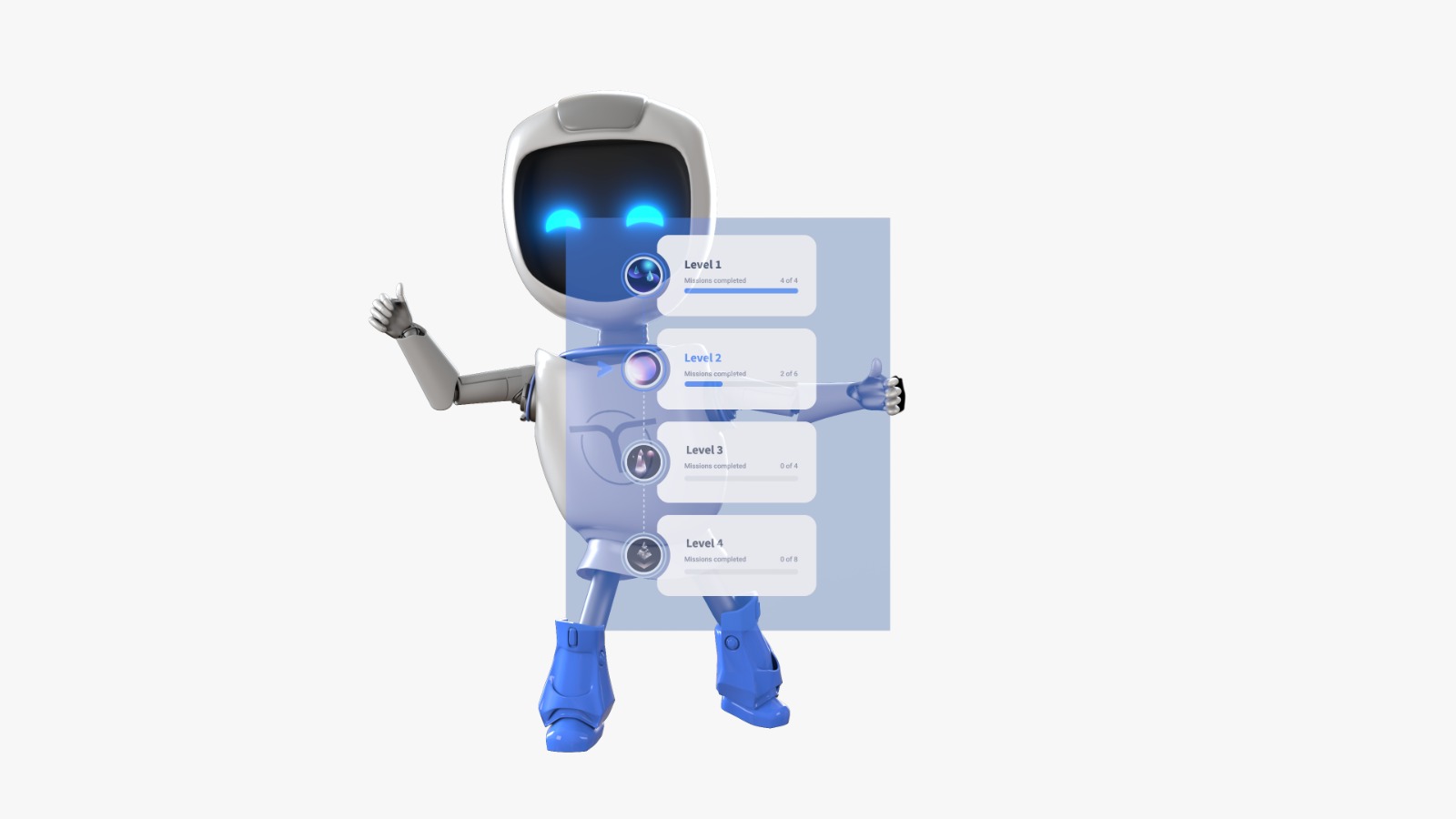Training restaurant staff is one of the most effective ways to tackle three major pain points in the industry: high turnover, low online ratings, and lost revenue. The hospitality sector has one of the highest quit rates in the U.S., over 70% higher than the national average, according to McKinsey. Meanwhile, poor service, inconsistent hygiene, and slow response times continue to drive negative reviews and missed profit opportunities.
But here’s the real issue: theory alone doesn’t work. For example, a controlled study found that while food safety knowledge improved significantly after training, that didn’t always lead to better on-the-job behavior. In other words, staff understood the material, but didn’t always apply it.
That’s why effective training must go beyond manuals and checklists. It needs to be active, job-specific, and built for fast-paced environments. In the next sections, we’ll break down the most important training topics, and show you how to teach them in a way that actually sticks.
How to Train Restaurant Staff: The Right Mix of Tools
Theory alone isn’t enough in a fast-paced restaurant. Staff need real-world practice in a format that’s quick, flexible, and engaging. That’s why modern staff training blends learning with doing, right on the job.
Today’s best training modules are also online, available on-demand, and work on both mobile and desktop. That means your team can learn in short bursts before a shift, during downtime, or even at home. Training doesn’t stop after onboarding anymore. Now, it’s part of the daily flow.
Microlearning: The Backbone of Modern Staff Training
Microlearning is the most effective way for training restaurant staff today. It breaks big topics into small, focused lessons (usually 3 to 10 minutes long) each covering just one concept. This format fits perfectly into the fast, unpredictable pace of restaurant life.
Instead of cramming everything into onboarding, microlearning spreads training out over time and space: on mobile or desktop, at home, during breaks, or between shifts. It helps staff learn faster, remember longer, and apply skills immediately on the job.
Microlearning supports a whole range of interactive, practical tools that make theory stick:
- Gamification: Keep staff motivated with points, badges, leaderboards, and friendly competition.
- Role Plays: Let your team practice live conversations in a safe environment, whether in-person or through digital recordings.
- Realistic Scenarios: Show staff what real service problems look like and let them decide how to respond.
- Proof Photos: Staff take and upload real photos—of a clean table setup, uniform checks, food labels, etc.—to show they’ve applied what they learned.
- Videos: Use short, relatable videos to show what great (or poor) service looks like and teach theory or complex ideas.
- Quizzes: Quick quizzes are perfect for things staff have to know right, like food safety, allergy protocols, and POS systems. They’re also great for reinforcing key takeaways.
- Self-Reflections: Give staff space to reflect on what they learned, what they struggle with, or how they handled a situation. This builds awareness and better habits over time.
- Peer Review and Mentoring: Encourage staff to give and get feedback, whether through buddy systems, digital comments, or manager check-ins.
Top 10 Restaurant Staff Training Topics
From food safety to guest communication, every training topic your team needs can (and should) be taught through a blend of core concepts and practical, hands-on learning.
Here are the 10 essential areas every restaurant should cover to build a service-ready team.
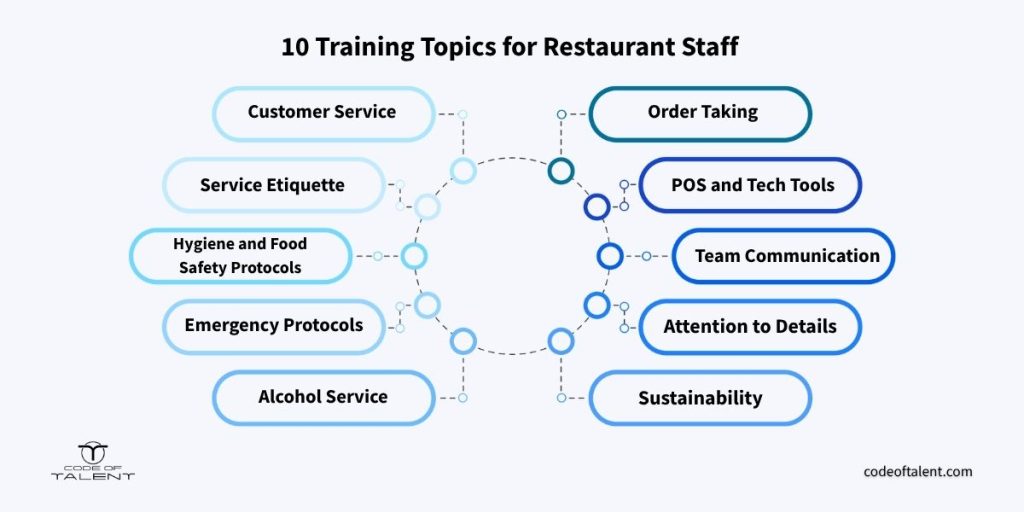
1. Customer Service Training for Restaurant Staff
Training restaurant staff in customer service means teaching them how to make guests feel seen, heard, and cared for. In restaurants, it’s the invisible thread that connects every part of the dining experience, from the first greeting to the final farewell.
Great customer service builds trust, turns first-timers into regulars, and helps teams recover when something goes wrong.
Theory
- Conflict Resolution: Staff should learn simple but structured ways to manage tension with guests. Introduce methods like the LAST framework (Listen, Apologize, Solve, Thank) to provide a calm, step-by-step approach.
- Emotional Intelligence and Stress Management: Teach how to stay calm during busy or emotionally charged situations. Focus on emotional regulation, reading guest cues, and managing internal stress.
- Empathy and Active Listening: Employees should be trained to genuinely understand guest concerns. This includes maintaining eye contact, paraphrasing concerns, and validating guest feelings.
- Verbal and Nonverbal Communication: Staff should understand that what they say is just as important as how they say it. Tone of voice, body language, eye contact, and facial expressions all shape how guests interpret their words.
- “Reading the Table”: Teach staff how to spot whether a table wants to chat, prefers privacy, or is in a hurry. Subtle awareness leads to better, more personalized service.
Practice
Scenario | Tool or Format | Example Activity |
A guest complains about cold food | Role play | Staff practice using the LAST method with a manager playing the guest |
Two guests are visibly upset, one is calm | Scenario branching | Staff choose who to address first and how |
Learning tone of voice and empathy | Video + quiz | Watch side-by-side examples of warm vs. cold tone, followed by reflection questions |
Practicing active listening | Peer review | Record a greeting or response and get feedback from a teammate or manager |
Teaching emotional regulation | Self-reflection | 3-minute module on staying calm under pressure + a prompt: “What went well in your last guest interaction?” |
Learning to “read the table” | Photo challenge | Staff snap a photo of a table and explain how they’d approach that guest |
2. Service Etiquette Training
Service etiquette is about delivering professionalism with polish. It’s the set of unwritten rules that shape guest experience, from posture and presence to the way a plate is placed on the table. These subtle cues create a sense of care and attention to detail, which is why service etiquette should be a top priority when training restaurant staff.
Theory
- Posture & Presence: Train staff to stand tall, stay alert, and avoid slouching, especially under pressure.
- Warm Greetings: Staff should match their tone and approach to different guest types (families, couples, business groups).
- Table Approach: Reinforce when and how to serve without interrupting or hovering.
- Subtle Upselling: Focus on guiding, not pushing. Staff should suggest based on guest cues.
- Table Setup: Teach staff to spot and fix setup errors fast. A clean, precise table speaks volumes.
Practice
Scenario | Tool or Format | Example Activity |
Learning to upsell naturally | Scenario + video example | Compare two videos: one pushy, one consultative. Discuss the difference in tone and result. |
Greeting different guest types | Branching scenario | Choose how to greet a solo diner, family with kids, or business group. Get feedback based on tone and word choice. |
Practicing posture and presence | Peer feedback or video | Record a mock table approach and get feedback from a teammate or manager on posture, eye contact, and flow. |
Reinforcing table setting rules | Photo proof challenge | Snap a photo of a correctly (or incorrectly) set table. Use for quick recognition training and discussion. |
Knowing when to approach a table | Microlearning module | Teach visual cues that signal when guests are ready to order, need help, or want space. |
Understanding service flow | Gamified checklist | Staff complete a sequence of etiquette steps during a mock shift and earn points for speed and correctness. |
3. Hygiene and Food Safety Protocols Training
Hygiene and food safety are legal, reputational, and financial lifelines for any restaurant. One overlooked protocol can lead to serious consequences: fines from health inspectors, bad reviews or viral social media posts, even lawsuits from customers. And with today’s guests more aware than ever, even small slip-ups don’t go unnoticed.
Theory
- Personal Hygiene: Reinforce handwashing, clean uniforms, glove use, hair control, and illness reporting.
- Cleaning vs. Sanitizing: Clarify the difference, plus tool separation, chemical use, and cleaning schedules.
- Storage & Handling: Teach the “first in, first out” (FIFO) rule, temp control, cross-contamination, and allergen safety.
- Regulations: Introduce local laws, HACCP basics, and inspection readiness.
Practice
Scenario | Tool or Format | Example Activity |
Learning proper handwashing | Short video + timed quiz | Watch a 60-second demo, then take a quick multiple choice quiz to check understanding. |
Reinforcing allergen protocols | Scenario challenge | Staff choose what to do when a guest mentions a nut allergy. Get feedback on accuracy. |
Cleaning equipment routines | Gamified checklist | Complete a digital “end of shift” cleaning checklist; earn points for order and speed. |
Recognizing cross-contamination risks | Photo-based quiz | “What’s wrong in this photo?” challenge. Select the safety issue in a kitchen image. |
Storing ingredients correctly | Microlearning + proof photo | Module on fridge storage order, followed by staff snapping a photo of their section for review. |
Refreshing legal compliance knowledge | Biweekly quiz rotation | Mini-quizzes every two weeks on local safety codes or HACCP steps to keep knowledge fresh. |
4. Emergency Protocols (e.g., fire, allergy, first aid)
Emergencies are rare, but when they happen, your staff need to act fast. Whether it’s an allergic reaction, a small fire, or a guest injury, safety comes down to training, calm thinking, and clear steps.
Theory
- Allergy Protocols: Avoid cross-contamination and respond quickly to guest reactions.
- Fire Safety: How to respond to stove or electrical fires, evacuation steps.
- First Aid Basics: Know when to intervene and when to call emergency services.
- Emergency Contacts and Communication: Who to notify, and how.
Practice
Scenario | Tool or Format | Example Activity |
Anaphylactic reaction | Scenario + branching decision | Choose the right steps and get feedback. |
Grease fire response | Short video + checklist | Watch a demo, then recall exact fire extinguisher steps. |
Guest collapse | Role play | Practice calling emergency services and securing the scene. |
Emergency drill | Timed challenge | Complete a timed simulation of exit routes and responsibilities. |
5. Alcohol Service and Responsible Beverage Training
Training restaurant staff to serve alcohol responsibly is crucial. They need to understand laws, guest safety, and how to handle intoxicated patrons without escalating situations.
Theory
- ID Verification: Recognize valid forms of ID and spot fakes.
- Signs of Intoxication: Learn to observe behavior, speech, and physical cues.
- How to Refuse Service: Do it legally and politely to avoid confrontation.
- Local Laws: Understand serving limits, liability rules, and closing-time policies.
Practice
Scenario | Tool or Format | Example Activity |
Spotting fake ID | Photo-based quiz | Choose which IDs are real vs. fake in a side-by-side challenge. |
Cutting off a guest | Role play + peer review | Practice refusing service respectfully and de-escalating a guest reaction. |
Tracking drink counts | Timed task | Monitor drink counts in a shift scenario. |
Alcohol law refresher | Quiz | Short module on regional liquor laws with 5-question quiz. |
6. Speed and Accuracy in Order Taking
Order-taking is where service speed and precision collide. Inaccuracy leads to delays, waste, and frustrated customers. But moving fast shouldn’t mean cutting corners. Staff need the right habits, focus, and tools to balance both.
Theory
- Active Listening: Confirming orders clearly and avoiding assumptions.
- Short-Term Memory Tricks: Using visual cues or shorthand to remember multi-item orders.
- Order Flow: Understanding how miscommunication impacts kitchen timing and guest experience.
- Double-Checking Methods: When and how to repeat back or verify complex orders.
Practice
Scenario | Tool or Format | Example Activity |
Taking a large table’s order | Timed simulation | Take a mock order in under 90 seconds and get feedback on accuracy. |
Memory recall | Flash challenge | View an order list briefly, then recreate it under a time limit. |
Handling modifications | Branching scenario | Choose how to record a guest’s allergy request and receive feedback. |
Avoiding order mix-ups | Peer review | Practice taking a teammate’s “complicated guest” order, then compare notes. |
7. POS and Tech Tools Proficiency
Speed at the POS is make-or-break during a rush. Staff must be confident using tech, whether it’s placing orders, splitting bills, or handling digital menus.
Theory
- POS Interface: How to navigate menus, edit orders, and process discounts or refunds.
- Digital Menus and Tablets: Using guest-facing tools effectively.
- Payment Systems: Handling various payment methods (e.g., contactless, split checks).
- Error Recovery: What to do if the system goes down or a mistake is made.
Practice
Scenario | Tool or Format | Example Activity |
Learning POS layout | Short presentation | Walkthrough of key buttons and workflows. |
Splitting a complex bill | Scenario + time challenge | Practice splitting bills with discounts for large groups. |
Dealing with a tech issue | Role play | Simulate a system crash. Staff will decide how to handle it with the guest. |
Entering special orders | Test | Input 5 guest requests with modifiers correctly under time pressure. |
8. Team Communication and Collaboration
A well-run restaurant depends on strong team dynamics, which can be achieved through effective training restaurant staff. From smooth handoffs to fast problem-solving, service only works when staff communicate clearly and respect each other’s roles.
Theory
- Clear, Concise Messaging: Especially in noisy or high-pressure environments.
- Respect Across Roles: Front and back of house (BOH) must collaborate, not compete.
- Conflict Handling: Know how to resolve tension respectfully before it affects guests.
Practice
Scenario | Tool or Format | Example Activity |
Kitchen–floor miscommunication | Scenario role play | Practice clarifying an order issue between FOH and BOH. |
Calling for support mid-service | Video simulation | Watch and react to a server calling for help while multitasking. |
Feedback practice | Peer review | Staff give each other positive or corrective feedback after a role-played service issue. |
Communication drills | Team challenge | Staff complete communication “reaction” scenarios and score on clarity. |
9. Cultural Sensitivity and Inclusion Training
Many restaurant teams are diverse, and so are the guests. But without training, miscommunication or unintentional offenses can hurt morale or alienate diners. Inclusion training helps everyone feel respected and valued and should be an essential step in training restaurant staff.
Theory
- Respectful Language and Gestures: Avoiding stereotypes, slurs, or body language missteps.
- Cultural Etiquette: Understand different guest expectations and dietary considerations.
- Bias Awareness: Recognizing unconscious assumptions in hiring or service.
- Creating Inclusive Spaces: Simple habits that make teams and guests feel welcome.
Practice
Scenario | Tool or Format | Example Activity |
Greeting diverse guests | Scenario + video demo | Watch and compare culturally respectful vs. dismissive service. |
Bias check-in | Self-reflection tool | Answer prompts about assumptions made during guest interactions. |
Team respect building | Peer mentoring | Pair team members from different backgrounds to discuss experiences. |
Dietary sensitivity | Quiz + scenario | Choose how to respond to cultural or religious dietary requests. |
10. Sustainability and Food Waste
Cutting food waste is good for both the planet and your bottom line. It lowers costs, appeals to eco-conscious guests, and improves your brand’s image.
But it only works when sustainability becomes part of daily routines, not just a policy. For example, a 2024 MDPI study found that restaurants with better training in green practices generated less waste, showing how staff education drives real impact.
Theory
- Guest Education: Confidently explain portion sizes, packaging, or water-saving steps.
- Prep & Portioning: Avoid waste through accurate prep, smart storage, and spoilage checks.
- FIFO: Use the “first in, first out” method to rotate stock efficiently.
- Leftovers: Know how to label, reuse, or discard safely.
- Reusable Materials: Handle eco containers and cutlery correctly.
- Energy and Water Use: Report leaks, turn off appliances are some small actions that save big.
Practice
Scenario | Tool or Format | Example Activity |
Over-prepping during lunch rush | Scenario + branching decision | Choose how much of each ingredient to prep; see how choices affect waste and speed. |
Teaching FIFO and storage | Photo proof | Staff take a photo of organized vs. incorrect fridge layout after a short refresher. |
Spotting waste in action | “Find the problem” video | Watch a 60-second kitchen video and identify 3 moments of unnecessary waste. |
Identifying reusable items | Quiz + visual aid | Match common items to reuse or discard bins using photo-based prompts. |
How to Create a Training Plan for Restaurant Staff
A successful restaurant runs on systems. Restaurant staff training is one of the most powerful systems you can invest in, especially in a fast-moving industry. Here’s how to build a successful plan for training restaurant staff that actually works:
1. Identify the Need
Before you build anything, you need to know what to fix or improve. Look at your day-to-day operations and performance data. What’s breaking down? Talk to team leads, observe service, and review recent performance to spot weak areas.
Common KPIs that signal training needs:
- High turnover or absenteeism
- Low customer satisfaction scores or bad online reviews
- Increased food waste or comp errors
- Long service times or order mistakes
- Failed health inspections
2. Choose the Right Platform
Your team needs training that fits their workflow, not the other way around. Modern restaurant training should be:
- On-demand and mobile-first
- Hands-on, not just theoretical
- Easy to update and scale
This is why microlearning is the answer to training restaurant staff effectively.
Code of Talent, for example, simplifies training design with AI. Just enter your restaurant’s website, and the platform can automatically generate custom modules based on your menu, service style, and policies, saving hours of manual work.
3. Choose the Right Format
Match your content with the right format. Mixing tools like gamification, videos, and real-life tasks keeps engagement high and theory practical.
The right platform should help you do this automatically. Code of Talent aligns each training topic with the best delivery format, choosing from over 10 available formats to keep training dynamic and effective.
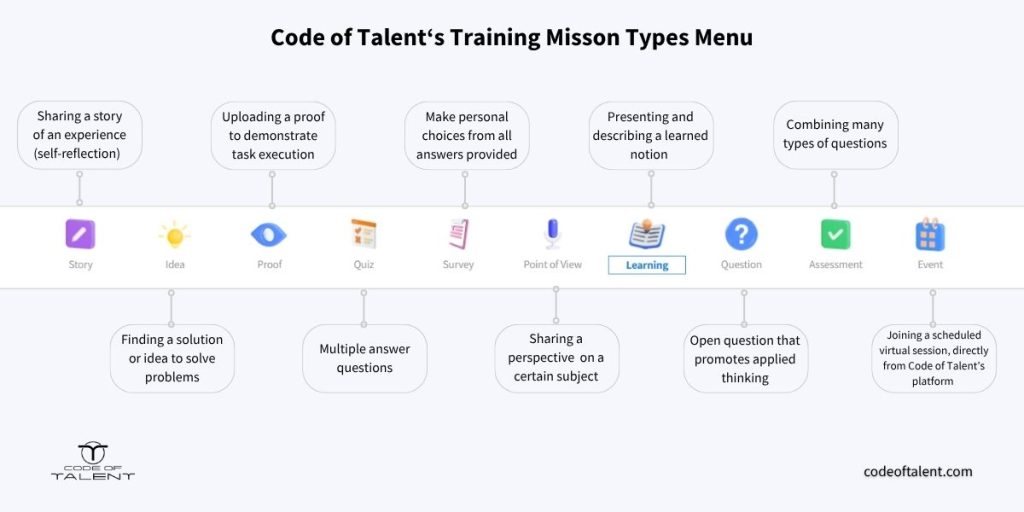
4. Set SMART Goals
Make your training goals Specific, Measurable, Achievable, Relevant, and Time-bound. Here are a few examples:
- Reduce order errors by 25% in 3 months
- Train 100% of staff on hygiene protocols within 14 days
Improve customer satisfaction score from 4.2 to 4.5 stars in 60 days
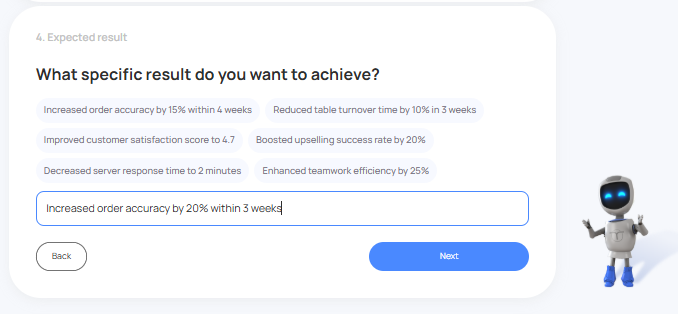
5. Nurture KPIs and Monitor Progress
Training doesn’t end with content delivery, so keep your eye on key metrics post-launch. Track progress in:
- Completion rates
- Quiz results
- Manager observations
- Guest feedback
Look for trends: Are your upsells increasing? Are wait times dropping? Use data to refine your training and keep improving over time.
6. Recognize Effort and Celebrate Wins
Recognition is part of training and scientifically proven to improve performance. For example, a field study in six fast-food outlets found that team-based recognition led to better engagement, fewer call-outs, and higher effort levels across the board.
Ideas for recognition:
- Shoutouts in team chats
- Certificates for module completion
- Leaderboards and point systems
- Small rewards for consistent progress
Gamification, once again, is a good example and a bulletproof example of a recognition system that works well with training.
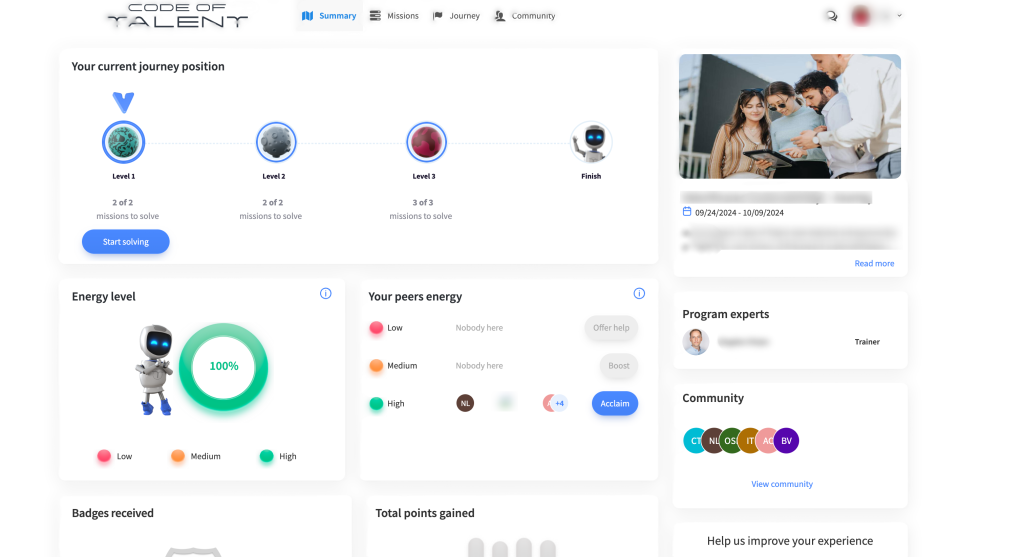
Simple Plan for Training Restaurant Staff
Effective training transforms restaurant teams into confident performers. When it’s practical and accessible, it improves retention and service consistency, helping your business thrive, even during rush hours.
Modern tools like microlearning, gamification, and interactive formats make this easy to implement without disrupting operations.
Try Code of Talent for free to instantly generate training modules based on your restaurant’s own materials. Whether you’re onboarding new hires or upskilling your team, training restaurant staff is easier, and more effective, when it’s built for the way your business actually runs!





